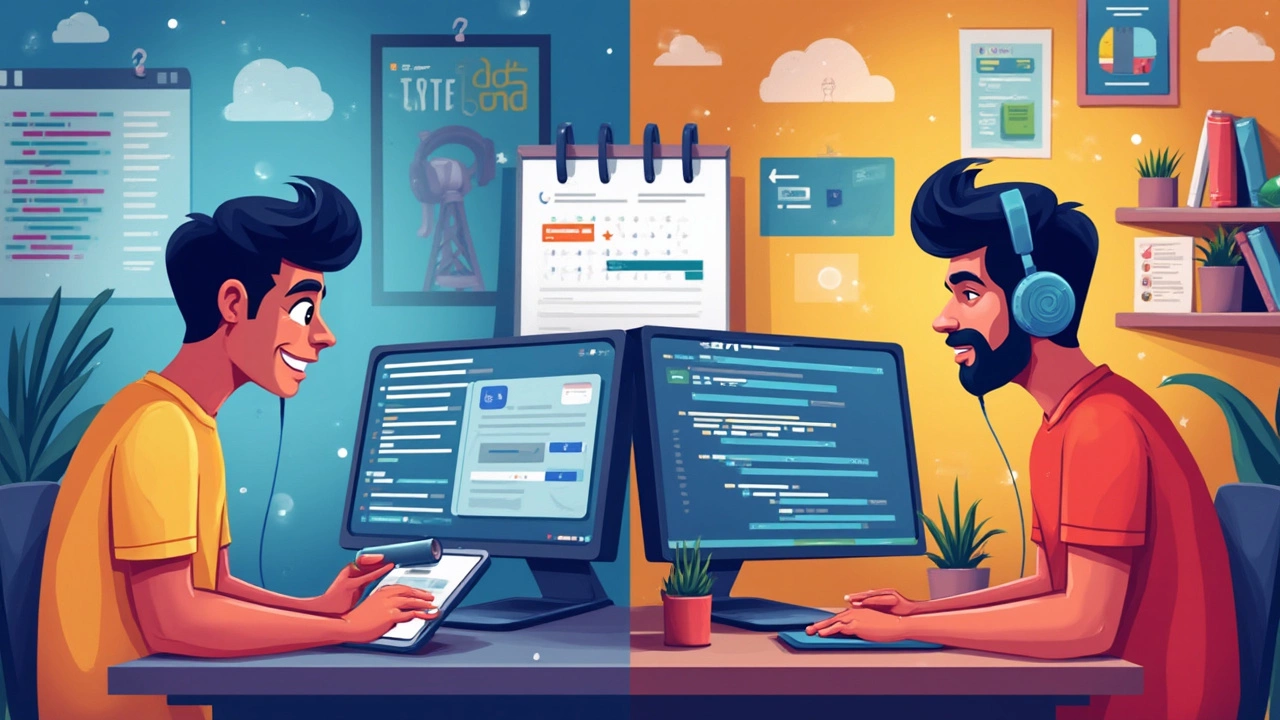
Ever sit down to code and wonder, “Am I doing enough? Too much? Not even close?” You’re definitely not the only one. There’s so much advice out there—some folks say crank out 10 hours, others swear by an hour a day. No one hands you a magic number when you start learning to code.
Here’s the thing: it’s not just about clocking endless hours, it’s about making each one count. Chugging through ten hours of YouTube tutorials back-to-back might sound hardcore, but real progress comes from what sticks and what you actually put into practice. If you’re just starting out, some beginners see the best results doing 30-90 minutes a day but doing it nearly every day. Intermediate or advanced? Your sweet spot might be two to four hours, with breaks or different challenges tossed in.
- Does More Coding Time Always Mean More Progress?
- Finding Your Ideal Coding Practice Window
- Telltale Signs You’re Practicing Too Much or Too Little
- Tips to Make Coding Practice Stick
- How Real People (And Pros) Structure Their Coding Days
Does More Coding Time Always Mean More Progress?
It seems obvious: practice more, get better—right? But with coding practice, quality actually wins over sheer quantity. Tons of newbies get hyped after hearing about programmers pulling endless all-nighters, but the human brain isn't set up for marathon focus sessions. In fact, studies from top universities show that productive focus on a new technical skill—like learning code—rarely lasts beyond two to four hours a day for most people. After that, your brain taps out, and mistakes shoot up.
Think of it this way: if you’re grinding eight hours straight in one sitting, chances are, half of that time gets wasted going in circles. You might remember the big 10,000 hour rule floating around tech circles. But recent research says it only works if you’re soaking in feedback, fixing mistakes, and actively solving new problems—not just repeating the same stuff on autopilot. So just sitting at your laptop for hours doesn’t make you a better coder unless you’re actually challenging yourself.
Let’s talk numbers. Here’s a quick snapshot from an online survey of self-taught developers and coding bootcamp grads:
| Daily Coding Hours | Reported Progress Rank |
|---|---|
| Less than 1 hour | Slow |
| 1-2 hours | Steady |
| 3-4 hours | Fast if consistent |
| 5+ hours (unstructured) | Lots of burnout, less retention |
See how the sweet spot lands around 1-4 hours a day? But here’s the catch: a solid hour—where you’re debugging, building, and making mistakes—does more for you than five hours where you’re half-listening and barely coding. That’s why people in coding classes are usually encouraged to break up their study time, mix in practice, and regularly step away to let things click.
Bottom line: it’s not about a magic number of hours. It’s about working on new challenges, paying attention, and giving yourself breaks so what you’ve learned really sticks. More coding time can help, but only if you use it smart.
Finding Your Ideal Coding Practice Window
Nailing down how much time you should practice coding isn’t about picking a random number you found on Reddit. Everyone’s brain works a bit differently, and your sweet spot for daily coding hours might not be the same as your friend’s. What really matters is consistency and focus—not just hitting a quota.
If you’re a beginner, research from Codecademy shows that steady learners who spend 1 hour a day coding, five to six times a week, finish basic tracks in about two to three months. Even the heavy hitters on Stack Overflow usually say that quality trumps quantity. After about 90 minutes of focused coding, most people’s brainpower starts dropping. Pushing past that can actually make it harder to remember stuff.
Think about your own schedule and energy. Got classes or a full-time job? It’s fine to break practice into chunks—maybe a 30-minute session before breakfast, then another burst after dinner. Remember, three short and focused sessions often beat one long, tired session. Here’s what a typical week might look like for different skill levels:
| Experience | Daily Coding Hours | Sessions per Day | Example Breakdown |
|---|---|---|---|
| Beginner | 1-1.5 | 1-2 | 1 hour after work, or 30 mins morning + 30 mins evening |
| Intermediate | 2-3 | 1-2 | 90 mins after school, plus an hour on projects later |
| Advanced | 3-4 | 2+ | 2-hour block, 1-hour problem solving, 30-min review |
One thing pros agree on: Always build in breaks. Set a timer for 25-45 minutes, then get up, stretch, and check your phone. Use the Pomodoro method if it helps—this style is a major hit with both beginners and experts. Your mind needs time to process new concepts, so don’t skip downtime.
Figure out the best window by testing what fits your life now and why you want to learn coding. If you're grinding for a job switch, you might need a bigger push. If you’re just exploring, there’s no rush. Track how focused you feel during each block and make adjustments week by week.

Telltale Signs You’re Practicing Too Much or Too Little
Here’s a reality check: You can hit a wall from coding practice overload just as easily as you can fall behind from not putting in enough time. The sweet spot? It sits somewhere between obsession and procrastination.
If you’re wondering which side of the fence you’re on, look out for these signs:
- Practicing Too Little: You keep Googling the same basic problems over and over. You struggle to recall simple syntax or concepts, even after multiple tries. You get easily distracted or bored during coding sessions. If you skip practice for days at a time, momentum just fades away—think of it as taking two steps forward, one step back.
- Practicing Too Much: You start dreading your next session. Your brain feels fried, and bug fixing turns into a guessing game. You can’t remember the last time you enjoyed coding. Studies have shown that after about 2 continuous hours, focus drops sharply for most people—breaks are not optional if you want to keep your mind sharp.
If you want the numbers, check out this quick breakdown researchers found helpful for new learners and hobby devs:
| Session Length | Per Week | Common Outcome |
|---|---|---|
| 0-2 hrs | <4 days | Slow progress, lots of review needed |
| 1-2 hrs | 5-7 days | Consistent growth, less "forgetting" curve |
| >3 hrs (no breaks) | Daily | High burnout risk, mental exhaustion |
There’s no badge for working until your brain melts. If you notice frustration growing or topics getting fuzzier, step away for a bit. Even seasoned devs take breaks to reset their focus. The right amount of daily coding hours will challenge you just enough to keep things interesting, without making you want to chuck your laptop out the window.
Check in with yourself regularly. If you’re not seeing tiny improvements week by week, or coding feels like a slog, adjust your rhythm. Sometimes less is more—and sometimes you just need to up the ante a bit.
Tips to Make Coding Practice Stick
Getting better at coding isn’t just about the raw hours you put in—it’s about making those hours actually stick in your memory and skills. If you want results from your coding practice, here’s what helps the most:
- Keep it regular, not random. Coding every day (even if it’s just 30 minutes) makes way more difference than cramming once a week. That’s how your brain locks in those tricky loops or function calls.
- Break it up. Long, non-stop marathons usually lead to burnout or zoning out. Try breaking your daily coding hours into 45-minute chunks with short breaks. The Pomodoro Technique—25 minutes coding, 5 minutes break—is a classic for a reason.
- Mix it up. Don’t just copy code from tutorials. Build little projects, fix bugs, join a coding challenge, or explain what you learned to someone (my spouse Gemma is my guinea pig for this). It pushes your brain in new directions.
- Track your progress. Use a simple spreadsheet or an app like Notion to jot down what you worked on. Looking back over a month, you’ll see wins you forgot even happened. Tracking keeps you honest—and motivated.
- Ask for feedback. Coding in a vacuum is tough. Push your code to GitHub, share it on forums, or even ask a friend to review it. Real feedback, even if it stings, is way more helpful than flying blind.
Curious about sticking with it? Look at these real numbers from a small group of learners who tracked how consistency versus hours affected getting past the “beginner wall”:
| Practice Frequency | Average Daily Hours | Percent Who Felt "Progress Stuck" After 8 Weeks |
|---|---|---|
| Daily | 1 | 15% |
| 3x/week | 2 | 38% |
| 1x/week | 5+ | 67% |
Coding every day—even briefly—helped way more folks get past feeling stuck, compared to those who saved it all for the weekend. So forget “all-nighters.” Think, “Can I code a little every damn day?” That’s how you’ll win.

How Real People (And Pros) Structure Their Coding Days
If you look at how everyday learners and professional developers actually set up their coding days, it’s way less rigid than you’d think. The best coders aren’t glued to a keyboard for 12 hours—they balance deep focus with breaks, review, and variety in what they do.
Take juniors fresh out of a coding classes bootcamp: most block out coding sessions in one to two-hour stretches, followed by something totally different (like lunch, gaming, or a walk). One survey from freeCodeCamp’s community (2023) found that coders who improved the fastest usually spent about 15-20 hours a week—but split into small daily chunks, not marathons.
Here’s how a pro’s typical weekday might look:
- Morning: One or two hours “deep work”—solving tough bugs, writing new code for main projects.
- Midday: Team check-in or code reviews—talking through code with others.
- Afternoon: Lighter tasks—refactoring old code, working on side projects, or learning something new like a framework update.
- Between tasks: Short breaks every hour. Real pros swear by the Pomodoro method (25 minutes coding, 5 minutes off).
Even people learning solo or after work use structure. My friend Jordan, juggling a day job, swears by 40-minute blocks each evening—20 minutes focused on learning to code with a new concept, then 20 actually building or fixing something. Weekends, it’s longer but less strict—he spends a few hours on coding practice, but only if he’s actually feeling up to it.
Some interesting stats:
| Experience Level | Average Daily Coding (Hours) | Preferred Session Length |
|---|---|---|
| Beginner | 1 to 1.5 | 30–60 min |
| Intermediate | 2 to 3 | 60–90 min |
| Pro Dev | 4 to 6 | 90 min (with breaks) |
The key is picking a schedule you can stick to, not what looks “hardcore.” Even folks at big tech companies don’t just code endlessly—their schedules mix up actual coding practice, meetings, and time to recharge. You’ll get more out of three focused hours than a whole unfocused day. If you’re on the fence, try tracking your time for a week and see what fits best for your brain and your life.





